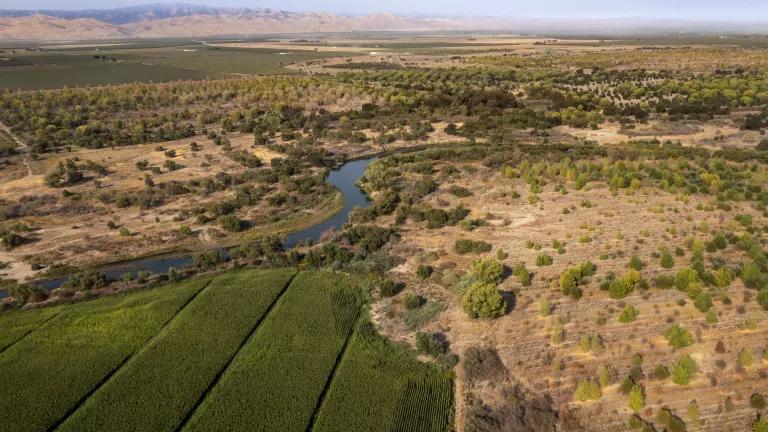California Proposes to Transition Away from Toxic Pesticides
California's proposal to update pesticide fees could offer better protections for farm workers, agricultural communities, and vulnerable ecosystems, as well as help farmers adopt more sustainable practices.

Child plays safely at organically managed Dover Street Edible Park in Oakland, California
California’s Governor broke new ground this year when he committed to “transition away from harmful pesticides.” His budget proposal to update fees charged on pesticide sales would generate new funding that could be used to offer better protections for farm workers, agricultural communities, and vulnerable ecosystems, as well as help farmers adopt more sustainable practices.
Pesticide use remains at a near-record high. And yet, the state’s pesticide fee structure has not changed since 2004. An update to California’s approach to dangerous pesticides is overdue.
For too long, the environmental and health costs of toxic pesticide use have been borne by society at large—and especially low-income communities of color. For example, although California banned chlorpyrifos last year, numerous similar pesticides continue to threaten kids’ brain development across the state, hitting farm workers and farming communities the hardest. Pesticides remain a widespread drinking water contaminant, particularly in rural areas, and exposure to these pesticides has been linked to increased vulnerability to COVID-19.
California's pesticide air monitoring network, which alerts the state to airborne pesticide pollution and potential health risks, shrank from eight sites to four in 2020. In addition, the state has no clear accountability mechanisms—or even community health measures—that follow from elevated pesticide levels in the air.
Pesticides also threaten our waterways and biodiversity, including the pollinators we rely on to grow a wide range of crops. California’s pollinator-dependent crops are worth $11.7 billion. But widely used pesticides like neonicotinoids threaten to destabilize the pollinator-based farming economy and interfere with the numerous ecosystem services that pollinators provide. In addition, pesticide pollution in water, including from pyrethroids and organophosphates, leads to declines in the aquatic food web.
Unfortunately, many farmers feel stuck on a costly and dangerous “pesticide treadmill,” where the purported solution to one pest problem creates imbalances that lead to another. While California farmers have successfully converted over 2.5 million acres to organic farming, stepping away from that treadmill for the first time is challenging, and programs like the Biologically Integrated Farming Systems Program (BIFS) that offer technical assistance to farmers interested in organic and other safer farming practices remain chronically underfunded. Instead, farmers must often rely on the guidance of Pest Control Advisors, who may work for agricultural chemical companies and earn commission from pesticide sales.
Governor Newsom’s proposal to update and tier pesticide fees, based on acute toxicity, is a welcome step in a new direction. The proposal would direct funds to enforcement, staffing for community engagement, and integrated pesticide management (IPM), including BIFS and a new IPM collaboration with public universities that would expand resources available for farmers.
As climate change compounds the burdens already carried by our farming communities, California’s approach to pest management must prioritize the urgent issues facing our most vulnerable people and ecosystems, and must engage farmers and farm workers as partners in the transition. To that end, NRDC and our partners are urging the Administration and Legislature to improve the Governor’s proposal by directing funding to four key areas:
Pesticide Relief Fund
Establish a Pesticide Relief Fund for agricultural communities negatively impacted by pesticide use. The Fund could be used to establish community green spaces and protective buffer zones, and to provide PPE, indoor air filters, and other immediate protections. Funds should be directed through a process by which residents in the areas of the state at greatest risk of pesticide exposure have power to decide and prioritize protections, based on their local pesticide and air quality conditions and what will work best for them.
Pesticide Air Monitoring Network
Restore and expand the pesticide air monitoring network to protect public health. Monitoring results should be linked to enforcement actions and increased oversight for use of dangerous pesticides detected in the air.
Pest Management Training
Expand programs, including BIFS, that facilitate farmer-to-farmer and farm worker pest management training focused on preventing pests and cultivating stronger crops through organic and regenerative farming practices that build healthy soil.
Ecosystem Monitoring Program
Create an Ecosystem Monitoring Program to establish baseline assessments for pollinators and other sensitive species, assess the impacts of pesticide use on biodiversity, and identify organic and IPM strategies and other interventions that maximize protection of ecosystems.
Overreliance on toxic pesticides is hurting the people of California and our natural resources. These key investments will move us closer to a holistic approach to pest management—an approach that recognizes farms are part of complex ecosystems. When soil and biodiversity thrive, without interference from dangerous pesticides, it makes plants, animals, and communities safer and stronger.




